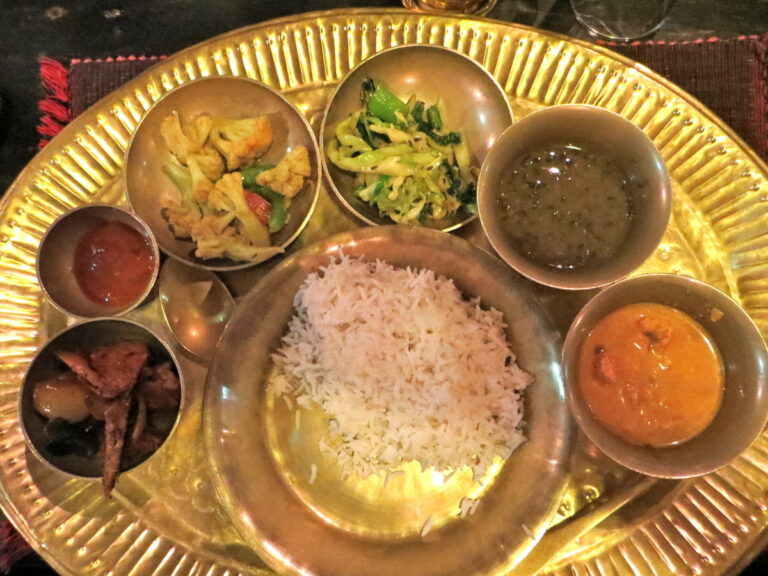Introduction: Regional Specialties in Nepalese Cuisine
Nepalese cuisine is a delightful blend of ethnic and regional flavors, with its roots tracing back to the Himalayas. The country’s diverse geography and cultural heritage have influenced the various regional specialties that make up Nepalese cuisine. From the spicy curries of the Terai region to the unique flavors of the mountainous Gurung cuisine, there is something for everyone in Nepalese cooking.
Newari Cuisine: A Must-Try for Foodies
Newari cuisine is a must-try for anyone looking to experience the authentic tastes of Nepal. It originates from the Newar community of Kathmandu Valley, which has a rich culinary tradition. One of its signature dishes is the famous “choila,” which is made with spiced grilled meat, usually chicken or buffalo. Another dish that shouldn’t be missed is “yomari,” a sweet dumpling made from rice flour and filled with sweetened sesame seeds, chaku, or khuwa.
Newari cuisine is also known for its unique use of spices, such as the “timur,” a type of Szechuan pepper that has a citrusy and peppery flavor. The cuisine also features traditional fermented foods like “aachar,” pickled vegetables or fruits, and “baji,” which is a fermented rice flour dish.
Thakali Cuisine: A Blend of Spices and Flavors
Thakali cuisine is another popular cuisine in Nepal, originating from the Thakali community of the Mustang district. The Thakali people are known for their trading and business skills, and their cuisine reflects their cosmopolitan outlook. The cuisine is a blend of Tibetan and Nepalese flavors, with a variety of spices and herbs that give it a unique taste.
One of the signature dishes of Thakali cuisine is “dal bhat,” which is a lentil soup served with rice and vegetables. Another popular dish is “thukpa,” a noodle soup that is perfect for cold winter evenings. Thakali cuisine also features a variety of meat dishes like “khasi ko masu,” a spicy goat curry, and “sukuti,” a dried meat dish that is perfect for snacking.
Gurung Cuisine: A Unique Taste of the Himalayas
Gurung cuisine is another unique cuisine in Nepal, originating from the Gurung community of the Annapurna region. The cuisine is known for its use of local ingredients and traditional cooking methods, such as roasting meat over an open fire. The signature dishes of Gurung cuisine are “dhi thulo,” a spicy beef curry, and “tama,” a fermented bamboo shoot dish.
Gurung cuisine also features a variety of vegetarian dishes like “phulaura,” a type of pancake made from lentil paste. The cuisine also has a range of beverages, including “jaad,” a traditional alcoholic drink made from fermented millet, and “chang,” a type of beer made from fermented rice.
Terai Cuisine: A Fusion of Indian and Nepalese Food
Terai cuisine is the cuisine of the Terai region, which borders India. The cuisine is a fusion of Indian and Nepalese food, with dishes that are spicy and full of flavor. One of the signature dishes of Terai cuisine is “masu ko bara,” a spicy meatball made with minced goat meat, lentils, and spices.
Other popular dishes in Terai cuisine include “alu tama,” a potato and bamboo shoot curry, and “chatamari,” a type of rice flour pancake topped with meat, vegetables, and spices. Terai cuisine also features a variety of sweets, such as “lalmohan,” a soft, spongy dessert made with flour and sugar syrup.
Sherpa Cuisine: A Delightful Mix of Tibetan and Nepali Dishes
Sherpa cuisine is the cuisine of the Sherpa community, which is primarily based in the Everest region of Nepal. The cuisine is a delightful mix of Tibetan and Nepali dishes, with a focus on hearty and filling meals. One of the signature dishes of Sherpa cuisine is “thukpa,” a noodle soup with vegetables and meat.
Another popular dish is “momos,” which are steamed or fried dumplings filled with vegetables or meat. Sherpa cuisine also features a variety of meat dishes like “sha bhaley,” a deep-fried meat pastry, and “khapse,” a deep-fried bread made with butter, sugar, and flour.
In conclusion, Nepalese cuisine is a rich tapestry of regional and ethnic flavors, reflecting the country’s diverse cultural heritage. From the spicy curries of the Terai region to the unique flavors of the mountainous Gurung cuisine, there is something for everyone in Nepalese cooking. So, next time you’re in Nepal, make sure to try out these regional specialties and taste the authentic flavors of the country.

